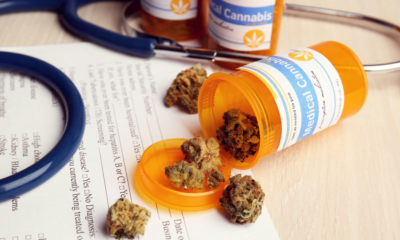Michael Sassano CEO and founder of SOMAÍ Pharmaceuticals, explains everything you need to know about the entourage effect.
There is much myth about the subjective yet real cannabis phenomenon called the “entourage effect.” Whether you’re a flower smoker, vaporizer/concentrate consumer, or edible taker, you want the full effect of the cannabis plant. The combined presence of terpenes alongside cannabinoids is proposed to yield a positive influence, hence the name “entourage effect.”
What Contributes to the Entourage Effect?
The three most influential categories of active ingredients in cannabis that create an entourage effect for consumer consideration are major cannabinoids, minor cannabinoids, and terpenes. Other lesser-believed effects may come from thiols, esters, aldehydes, and flavonoids.
Major Cannabinoids
The two major cannabinoids present in cannabis are delta-9 tetrahydrocannabinol (THC) and cannabidiol (CBD).
THC is the psychoactive ingredient associated with cannabis’ euphoric feeling. A synthetic delta-9 THC pharmaceutical known as Dronabinol has a 99% pure THC content. Although pharmaceutical and scientific people prefer to isolate THC, consumers are not interested in the intense effects of 99% pure THC products. Although consumers seek high THC in flowers and vapes and measure their oral solutions by THC content, there is a preference for other active ingredients also to be present.
CBD, another major cannabinoid, also binds to the CB1 and CB2 receptors. What this means is that in conjunction with THC, both are competing for the same CB1 and CB2 receptor spaces available. The combination of the two provides for a more pronounced effect than solely THC. Many people do not like the effects of THC and use CBD, but pure 99% CBD is also not preferred; for consumers who want an excellent CBD feeling without the THC, a balanced effect with a little THC and other cannabinoids is generally preferred.
Although isolated, pure active ingredients are the preferred route for scientists, they are not the consumer’s preferred experience, which fundamentally speaks to the entourage effect. Simply combining ratios of THC and CBD will have an overall difference in effect; consumers prefer formulations with high CBD and low THC, balanced 1:1 THC and CBD ratios, and high THC with low CBD combinations.
Minor Cannabinoids
The scientific community believes the most promising science for future treatments can be derived from minor cannabinoids.
There are an estimated 120 different minor cannabinoids that have been studied significantly less than CBD and THC. The most popular known and researched minor cannabinoids are cannabigerol (CBG), cannabichromene (CBC), and cannabinol (CBN). Other noteworthy minor cannabinoids include THC’s various chemical forms like tetrahydrocannabivarin (THCV) and tetrahydrocannabinolic acid (THCa), which can be used instead of THC to reduce the compound’s psychoactive properties and side effects while still receiving its benefits.
Flower and extracts all have major and minor cannabinoids in different ratios. They may be presented as a full- or broad-spectrum product or isolated into a single-spectrum product. A pure isolate product is not very attractive to consumers or useful other than for studies, and there is a more beneficial effect in combination.
In addition to major cannabinoids, flower and extracts may have 0.5 to 15% minor cannabinoids. Sativa and Indica strains will have various minor cannabinoid profiles, many of which can contribute to consumers’ energetic or sleepy feelings. Each minor cannabinoid profile has scientific properties, such as reducing inflammation, inhibiting cancer cell growth, slowing bacterial growth, promoting bone growth, treating fungal infections, aiding with sleep, relieving pain, reducing muscle spasms, etc.
When you look at what you are smoking or taking orally, major and minor cannabinoid combinations are principal actors in eliciting the entourage effect.
Terpenes
Hundreds of botanic terpenes in nature have been studied by herbologists for centuries. These sensitive components of a cannabis plant are highly developed to, for example, ward off predators. In cannabis, terpenes smell amazing and have profound additional effects on cannabis interaction with the consumer.
Some of the most common terpenes (and their potential effects) are:
- Myrcene (relaxing)
- Linalool (sedative)
- Terpinolene (uplifting)
- Limonene (stress relief)
- Pinene (soothing)
- Caryophyllene (pain relief)
- Valencene (euphoria)
- Borneol (sedative)
- Eucalyptol (relaxing)
All of the above terpenes are found not only in cannabis but in most plants. The terpenes that mimic the aromatic qualities of the living cannabis plant are the third major contributor to the entourage effect.
One sad issue is that when cannabis is dried and then smoked or extracted, the dried flower retains much of the major and minor cannabinoids, but terpenes are reduced to 0,5-3% of the flower while THC and CBD may be 12-30% of the weight and minor cannabinoids 5-15% of the weight. Both smoking dried flower and orally consuming extracts means taking a reduced terpene amount well below that of a typical living flower.
For this reason, the fresh-frozen live resin category has gained popularity for capturing major cannabinoids, minor cannabinoids, and terpenes as they existed in the live plant. The result can be up to 15% terpenes and a very robust taste profile. Additionally, extractors use various techniques to re-introduce terpenes by pulling them out before extraction or using botanically derived terpenes to enhance products such as vaporizers or oral solutions.
Other Minor Factors
- Thiols are believed to contribute to the “skunk” smell of cannabis.
- Esters are believed to bring fruity flavoring and may mitigate the effects of terpenes.
- Aldehydes may chemically change the terpene makeup.
- Flavonoids may influence color and have a few therapeutic effects.
What Does Not Contribute to the Entourage Effect?
Although people believe there are many categories contributing to the entourage effect, terpenes, and major and minor cannabinoids are the golden triangle.
However, plant materials, chlorophyll, carbohydrates, fatty acids, lipids, polyphenols, and other undesirables without any proven medical or psychological effects do not seem to contribute to cannabis’ entourage effect. To some degree, such materials may not even be healthy to smoke or consume. As much as people like smoking the flower, there are indeed parts of the plant that may not be healthy to the lungs or useful to take orally. Extractors have grappled with this issue for decades, trying to mimic the flower’s natural effect but recognizing the need to remove undesirables and add back things like terpenes to recreate the exact entourage effect that makes flower so popular.
However you define the entourage effect, the important thing is to find a clean and safe way to consume cannabis that targets your condition or indication. Keep track of major and minor cannabinoid ratios that contribute to your enjoyment. Peruse aromas, be aware of terpenes’ effects, and consume active ingredients that make sense for how you feel or what you try to cure. Above all else, avoid unhealthy products without consumption benefits.
READ MORE: Four things to know for properly dosing oral cannabis formulations

Michael Sassano, CEO and founder, SOMAI Pharmaceuticals
Michael Sassano is celebrated in mainstream business and biopharma media as an international authority on developing large-scale cannabis infrastructures throughout the world and the most advanced pharmaceutical cannabinoid products. Michael is also widely respected for successfully predicting long term cannabis market trends and movements, which he generously shares in many forums. He is well known for leading a merger of the cannabis cultivation company he built and operated, called Solaris Farms, with The Sanctuary.
Over the last few years, Michael has shifted focus to his role as CEO and Chairman of the Board for SOMAÍ Pharmaceuticals LTD, a European pharmaceutical and biotech company centred on manufacturing in Lisbon, Portugal and distribution of EU GMP-certified cannabinoid-containing pharmaceuticals throughout EU.

 News6 months ago
News6 months ago
 Science5 months ago
Science5 months ago
 Industry6 months ago
Industry6 months ago
 News6 months ago
News6 months ago
 News5 months ago
News5 months ago
 Health5 months ago
Health5 months ago
 News5 months ago
News5 months ago
 Health3 months ago
Health3 months ago













